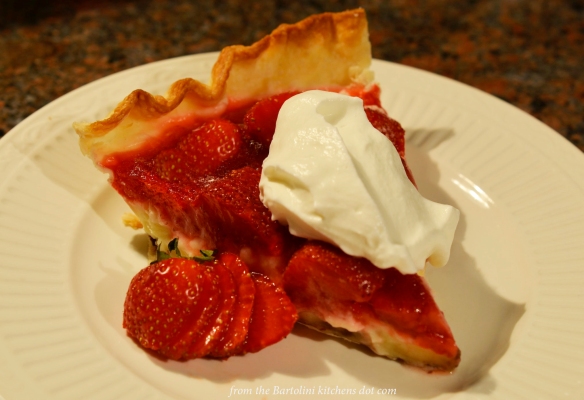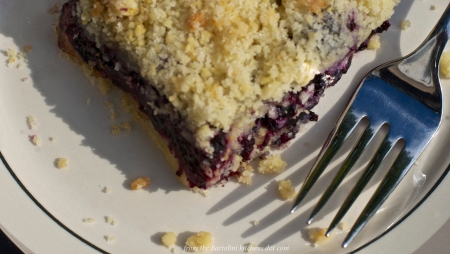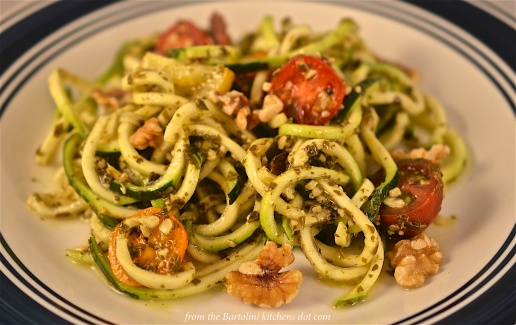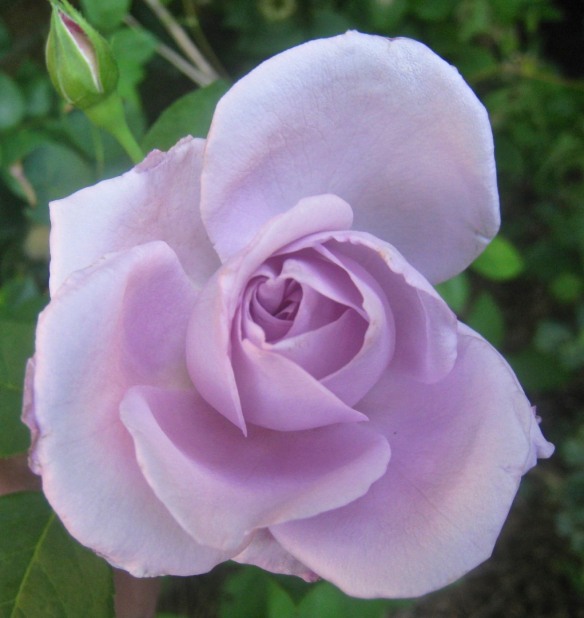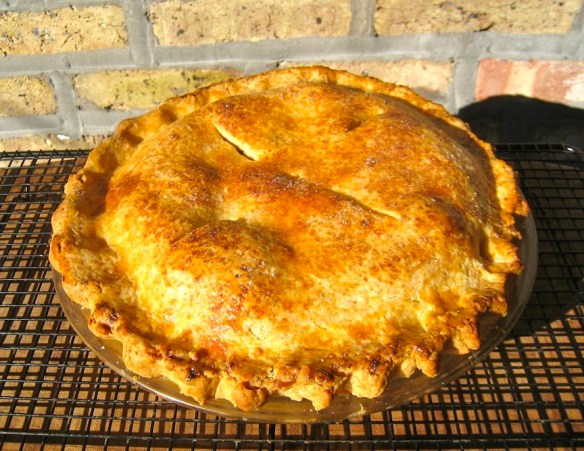I really cannot explain why this recipe was overlooked for so long. Granted, it wasn’t one that Mom prepared frequently — we were a strawberry shortcake family — but she did make this pie at least once a year. And how I loved it! I was walking around the farmers market, looking at all the fresh strawberries, when I remembered this treat. After buying a quart of strawberries, I rushed home, stopping along the way at a grocery to buy the rest of the ingredients. It wasn’t very much later that I had a strawberry-banana pie chilling in my fridge. A few weeks more and I prepared another while visiting Zia. Now, several months later and with my birthday looming in the near future (it’s Sunday, you know), I thought this the perfect time to share the recipe for Mom’s strawberry banana pie — and my personal favorite. Happy birthday to me!
The recipe I’m sharing is memory-based, for there is nothing written to follow. As you’ll soon see, however, the recipe is easy enough to reconstruct, although I did make a couple of changes. In the first place, I believe Mom used a pudding mix — sometimes vanilla, other times banana — and I do not recall her make pudding from scratch for this pie. The recipe I initially followed was printed in the recipe book that came with my first microwave, bought after I moved to Chicago in 1980. Never throw away a cookbook.
Then again, there are times when maybe you should toss a cookbook. When I prepared its vanilla pudding recipe, it was far too thick and not nearly as creamy as remembered and, therefore, not worthy of Mom’s pie. So, I made a couple of adjustments. I cut the amount of cornstarch, used 3 egg yolks instead of 2 whole eggs, and used less vanilla. The result was a pudding fit for Mom’s pie, just thick enough not to be runny yet creamy enough to wash over your palate. I, like the pudding, was all set.
I could not recall what, if any, glaze Mom used with the strawberry topping. I chose strawberry flavored gelatin, thinking it would both set the berries in place and prolong their shelf life. I did consider making the pie without the strawberry topping, using fresh berries to garnish each piece when served. If you prefer to do that, you should cover the pie with plastic wrap to prevent a film forming on the pudding.
It’s my idea to add a thin coating of chocolate to the pie crust. Living alone, my pie will not “disappear” as quickly as Mom’s did. The chocolate coating will prevent the pie crust from getting soggy as the pie sits. (I can say, with some certainty, that from my earliest days I have never liked a soggy bottom.)
* * *
* * *
Strawberry-Banana Pie Recipe
Ingredients
for the pie
- 1 pastry crust large enough to cover a deep, 9″ (23 cm) pie dish – store-bought may be substituted
- ⅓ cup semi-sweet chocolate chips
- 2 tbsp whole milk
- 1 banana, sliced
- vanilla pudding, recipe follows
- 12 oz (340 g) fresh strawberries, cleaned, hulled, and halved or sliced
- strawberry flavored gelatin, instructions follow
- whipping cream for serving
- shaved chocolate for garnish (optional)
for the vanilla pudding
- ⅔ cup sugar
- 3 tbsp cornstarch
- ¼ tsp salt
- 2 cups whole milk
- 3 egg yolks, slightly beaten
- 2 tbsp butter
- 1 tsp vanilla
* * *
* * *
Directions
to prepare the vanilla pudding
- Whisk together the sugar, cornstarch, and salt before adding ½ cup of milk. Continue whisking until fully combined.
- Add remaining milk and microwave on high for 5 or 6 minutes, stirring occasionally. Pudding should be smooth and thick.
- Temper the eggs by adding a few ounces of the hot liquid to the eggs, stirring all the while. Begin stirring the hot liquid as you add the egg mixture to it.
- Microwave on high until the pudding just begins to boil, about 1 minute.
- Add the butter and vanilla to the pudding, stir well, cover with plastic wrap (see Notes), and set aside to cool.
to prepare the pie crust
- Pre-heat oven to 450˚ F (230˚ C).
- Use whatever type of pasty crust that you prefer — homemade or store-bought — and use it to cover a deep, 9 inch (23 cm) pie plate/pan.
- Use a fork to puncture the pie crust before baking for 10 to 12 minutes in the pre-heated oven. Crust should be golden brown. Remove to cool.
- Once the crust has cooled somewhat, melt the chocolate chips and warm the milk.
- Add the milk to the melted chocolate and whisk to create a ganache (see Notes.)
- Use a pastry brush to lightly coat the bottom of the pie crust with the melted chocolate.
to prepare the gelatin
- Follow the package directions to quickly prepare the gelatin using both boiling water and ice cubes.
- Once the gelatin is dissolved and the ice cubes have melted, add the halved/sliced strawberries and gently stir.
- Refrigerate for 30 minutes.
to assemble the pie
- Once the pie crust has set and the chocolate coating hardened, coat the chocolate with a bit of pudding.
- Evenly space the sliced bananas across the pie’s bottom.
- Use as much pudding as is necessary to coat the sliced bananas. Be sure to leave room on top of the pudding for the strawberries. Use an offset spatula to even the top of the pudding.
- Use a slotted spoon to place the strawberries atop the pudding. Carefully pour the gelatin to cover the pudding and coat the strawberries.
- Place excess gelatin and strawberries into serving bowls. Once set they may be served to those poor unfortunates who do not like pie.
- Refrigerate at least 2 hours to let the pie fully set. The longer the better.
- Serve garnished with freshly whipped cream and shaved chocolate (optional).
* * *
* * *
Notes
You can make this pie any number of ways, from the very simple — use store-bought pastry and instant pudding mix — to the more involved — make your own pastry, pudding, and strawberry glaze. No matter how you choose to prepare it, you’ll find this pie makes a fine dessert.
I bet that a few of you gasped and clutched your pearls when you read that I had prepared the pudding in the microwave. Release the pearls! Martha Stewart’s vanilla pudding recipe is a good one and is prepared in a more traditional way.
Whatever type of pudding you prepare, be sure it is on the firm side so that the pie doesn’t collapse as the runny pudding fills the empty place left when you serve a piece of the pie.
Although I like the chocolate coating for the pie’s crust, you’ll create new problems if the chocolate is rock-hard when solid. Remember you’ll have to cut through it to serve the pie. Use enough milk to make a ganache that will stiffen without getting too hard. Either that or make the chocolate coating as thin as possible.
* * *
It’s déjà vu all over again …
Since today’s recipe was a dessert, why not end this post with another? This Blueberry-Lemon Slice is the perfect combination of tart and sweet and not at all difficult to prepare. It’s also a tasty way to use some of those blueberries if, like me, you freeze a couple quarts every summer. You will see the recipe when you click HERE.
* * *
Coming soon to a monitor near you …
Zucchini “Noodles” with Walnut Pesto
* * *

